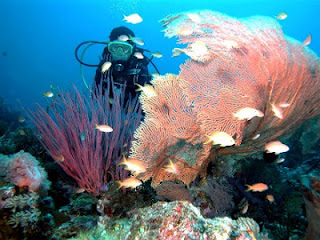Situated in the northwest of Bali and is part of the Bali Barat National Park, Menjangan (Deer) is an island with 1,5 km long and 500 m wide. With its beautiful reef flat, the island became Bali's first internationally recognized diving spot in 1978. Consequently in 1997, the extensive reef flat at the island suffered damage from crown of thorn starfish, and coral bleached by El Nino in 1998. But the wall, for which Menjangan is most famous-is still in excellent condition. This park is actually quite large; it encompasses much of Bali's western end and is also worth a visit. You will find forests, savanna, mangroves and the rich marine habitats of the Java Sea (only about 12 individuals still live in the wild, others can be seen in the bird parks in Bali) lives here. You can also see deers, wild boars, long-tailed macaques and leaf monkeys.
Menjangan Island is surrounded by beautiful white sandy beaches. It is a good place for scuba diving and snorkling with coral formations close to the shore. These unique features have given rise to a great number of large and smaller caves, festooned with sponge and soft corals and often inhabited by large groupers, moray eels and in the smaller caves by young snappers and batfish. The seabeds are also rich in large barrel sponges and vibrant sea fans, some of which are truly enormous. Given the depth, the moderate flow of current and protection from strong winds, it is common to see tuna, shoals of jack-fish, batfish, angelfish, sea turtles, and on occasion, sharks, especially off the outer corners of the island.
Dive Sites
Anchor Wreck
Anchor wreck (Kapal Budak), also called the Anker, is an old wooden shipwreck, which sits on the western tip of Menjangan at 40 meters. The name comes from a heavily encrusted anchor, which sits at about 6m on the top of the reef nearby. There is a second anchor close to the wreck at about 30m. The wreck lies on a fairly steep slope in bits and pieces, the bow towards the shore (30m), the stern at about 46m depths. There are some pieces even further down around 50 m. The ship is small (perhaps 30m long, it might be sailor boat probably from the 19th century. There are glass and ceramic bottles in cooper receptacles, which might have contained palm whisky or arak.
Eel Garden
Dive Sites
Anchor Wreck
Anchor wreck (Kapal Budak), also called the Anker, is an old wooden shipwreck, which sits on the western tip of Menjangan at 40 meters. The name comes from a heavily encrusted anchor, which sits at about 6m on the top of the reef nearby. There is a second anchor close to the wreck at about 30m. The wreck lies on a fairly steep slope in bits and pieces, the bow towards the shore (30m), the stern at about 46m depths. There are some pieces even further down around 50 m. The ship is small (perhaps 30m long, it might be sailor boat probably from the 19th century. There are glass and ceramic bottles in cooper receptacles, which might have contained palm whisky or arak.
Eel Garden
This diving site is named after a large colony of garden eels and lies on the western point of Menjangan. It is also called Pos I for the nearby guard post of the park service. The dive starts on a nice wall (about 40m) with a lot of beautiful gorgonians and other sea fans. Then you continue your dive over the top of the reef to a stretch of white sand. Take your time to observe the white garden eels. At one occasion discovered a small ghostpipe fish just where the reef starts again. From here turn either right to the reeftop or follow the edge of the sandy area to the left. There are several large blocks of coral, which are cleaner stations with clearer shrimps, a plenty beneath them.
The Post II
The post II Ranger station is located on Menjangan's most southeasterly point, and can be a boat entry or a beach entry. It is usually a relaxing drift dive. The dive starts at 12 meters where the white sandy slope meets the top of the wall. Slowly descending the wall, drifting with the current you will see a profusion of soft corals, sponges, and an abundance of gorgonian. This stretch is also the best place on Menjangan to see big animals such as mantas, sharks and other pelagic (depending on season and conditions).
Underwater Caves
These caves lie west of Pos II at about 18m. On the way see a yellow frogfish on a sponge, which made your day! You may also see a large gray and green Notodoris serenae nudibranch (about 10cm) and also a banded snake eel. The cave was nothing out of the ordinary, but there are quite a lot of nice grottoes and crevasses, nooks and crannies with gorgonians and sponges all over Menjangan. The drop off is a wall dive. See a batfish, a juvenile still with its edge a fiery orange and some scorpionfishes and large angelfishes. An interesting sight were masses of small dwarf hawkfish (Cirrhitichthys falco) on a huge sponge. In the right season you can supposedly also see mantas and sharks here.
Similarly, information about the best diving sites in Menjangan Bali. Snorkeling and diving is the right thing if you want to see the location of underwater paradise that is located here. Hopefully this article can serve as a reference for the tourists who will plan dives in Menjangan Island, Bali.
Advertisement






EmoticonEmoticon